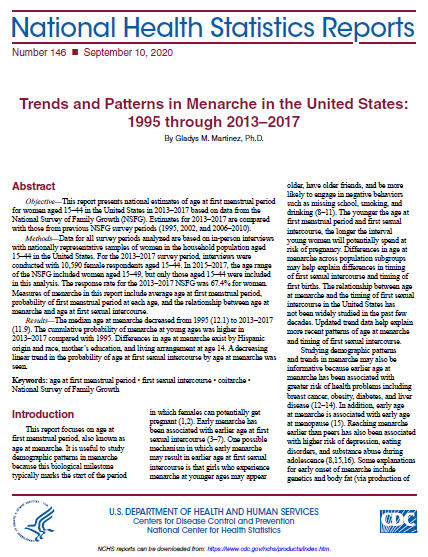Trends and Patterns in Menarche in the United States: 1995 through 2013-2017
Posted on by Questions for Gladys Martinez, Health Statistician and Lead Author of “Trends and Patterns in Menarche in the United States: 1995 through 2013-2017.”
Questions for Gladys Martinez, Health Statistician and Lead Author of “Trends and Patterns in Menarche in the United States: 1995 through 2013-2017.”
Q: Can you explain what menarche is?
GM: Menarche refers to the first menstrual period.
Q: Why did you decide to do a report on this topic?
GM: We decided to do a report on this topic because menarche is a biological milestone of the start of the period in which women can potentially get pregnant and because early menarche is associated with greater risk of health problems such as breast cancer, liver disease, etc.
Q: How did you obtain this data for this report?
GM: Data for this report came from a national sample of U.S. women aged 15-44 who were interviewed in person in 2013-2017.
Q: Is this the first report on age of first menstrual period? Is there any trend data that goes back further than 1995?
GM:
This is the first report on age at menarche. We do not have published data before 1995, however there is data available on the mean age of menarche in previous National Survey of Family Growth reports. This is the first full report on age at menarche and the first to use this methodology to look at the probability of age at menarche by each age
Q: What is the take home message for this report?
GM: Age at menarche has decreased in the U.S. since 1995. A higher proportion of young girls are experiencing menarche now than in earlier time periods. Girls from higher socioeconomic status and those that lived with both parents by age 14 were less likely to experience menarche at an early age. On average, the older the age at menarche, the older her age at first sexual intercourse.
Posted on by

